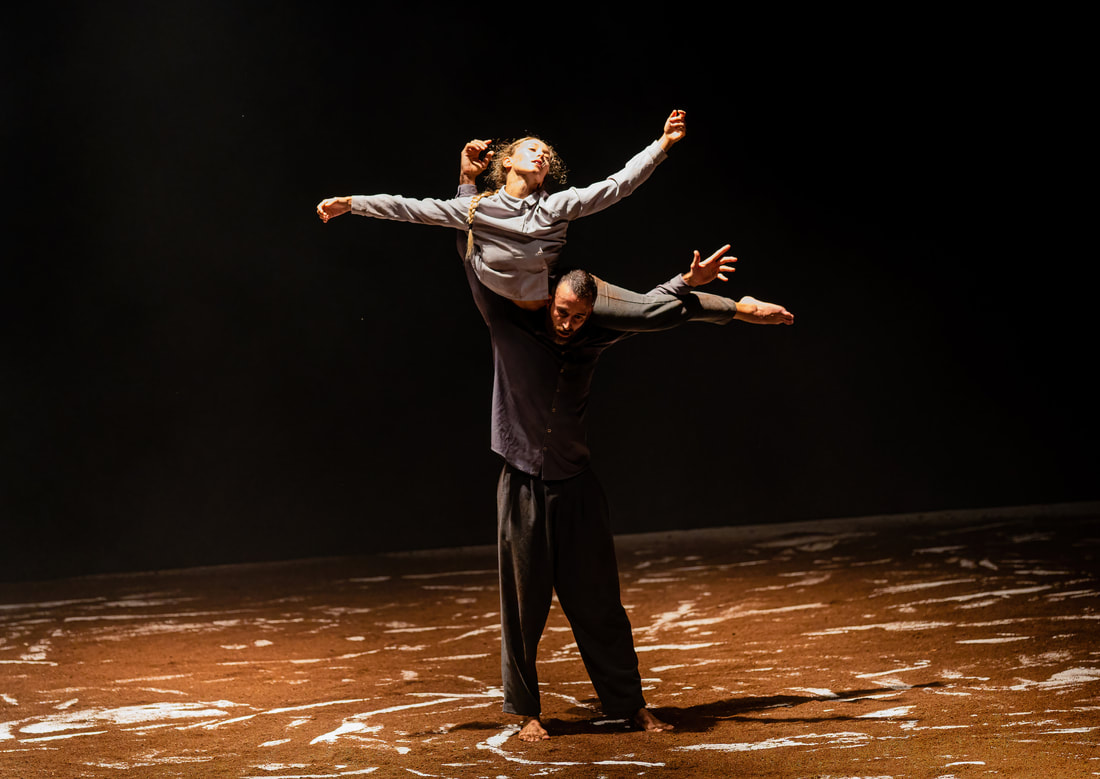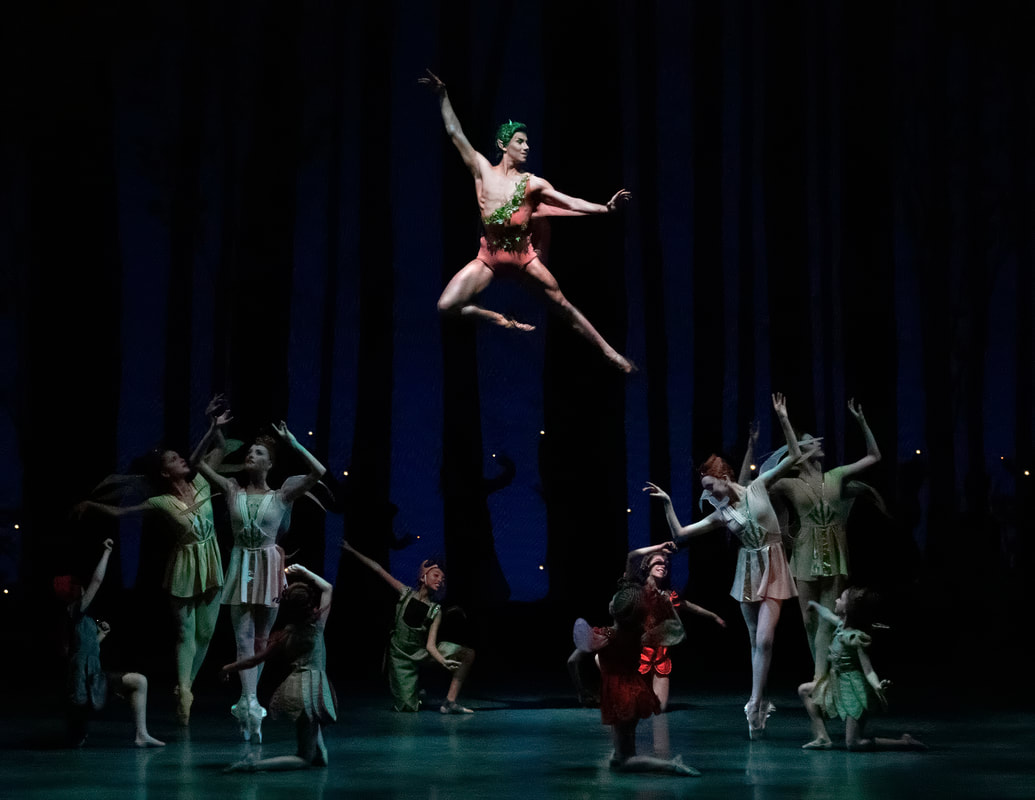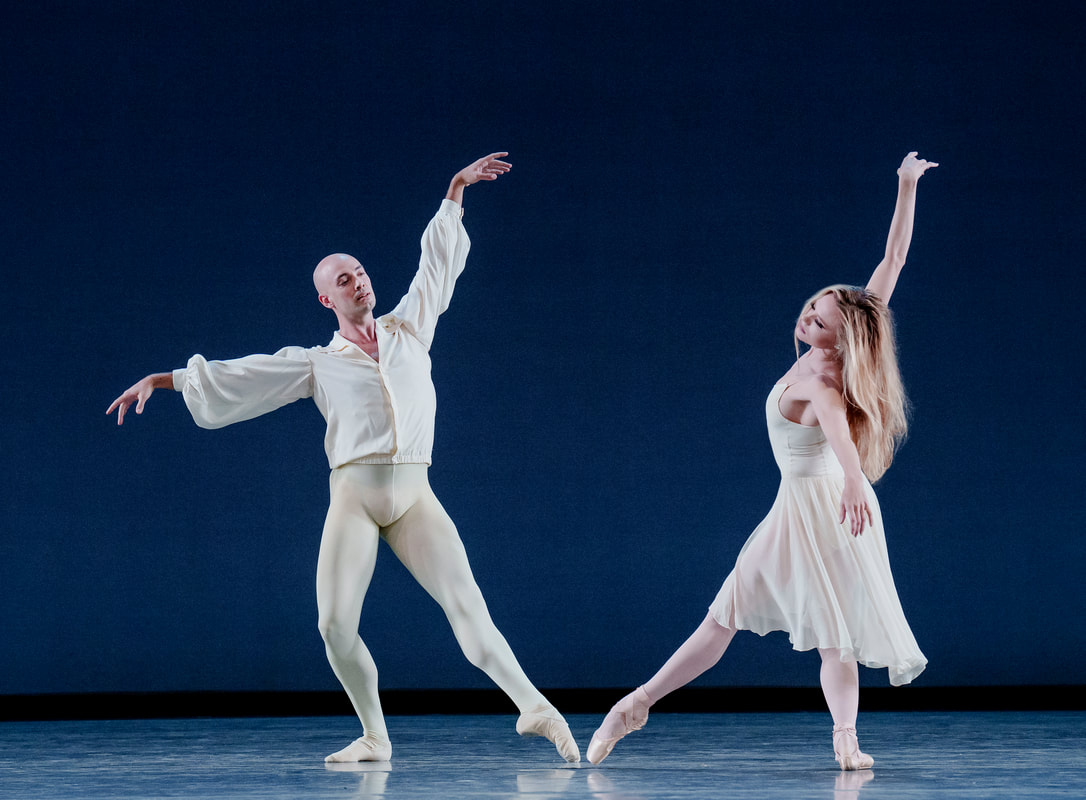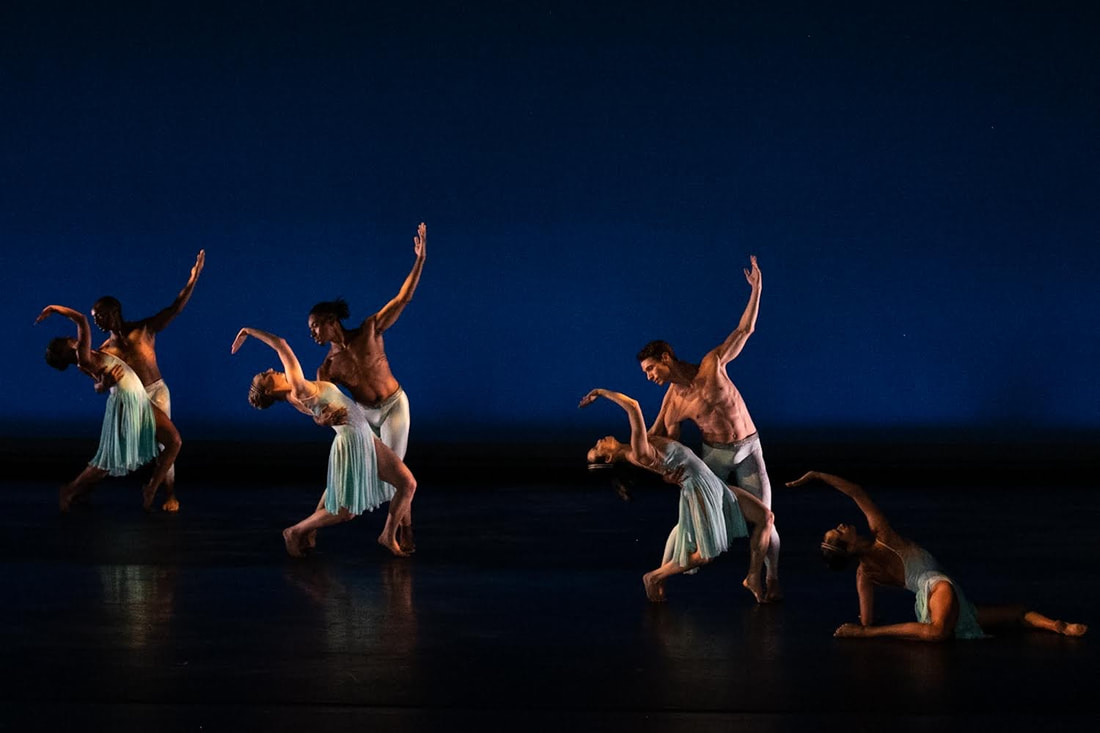|
The Israeli dance ensemble Vertigo, with Sian Olles and Daniel Costas, brought its dark and dramatic "One. One & One" to PS/21 in Chatham. (Photo by Steven J. Taylor) Noa Wertheim describes her work “One. One & One” as an “individual’s wish to be whole whilest being challenged constantly by a fragmented reality within the personal, existential and spiritual realms of one’s being.”
But the dramatic piece, as performed on Friday night at PS/21 by the amazing Vertigo Dance Company, is so much more. To me, the hour-long work, was a powerful indictment on the direction of the world at large, one where societies across the globe are ravaged by war and climate change – and each one (and one and one) is a victim. This excellent Israeli dance ensemble gripped the viewer with its poise and presence. And with music composed by Avi Belleli, which swung from beautiful to frightening, the work held sway. The piece opened with Sian Olles centerstage, twisting and reaching with her limbs like a strong sapling seeking the sun. Upstage was another dancer who steadily and neatly shook out a bucket of soil. In gray and brown costumes, by Sasson Kedem, that referenced the everyday worker, the line of dirty made one consider farming, the neat rows of a field with Olles as the elegant tree in its center. The serene scene quickly turned when the ensemble of nine took the stage for what felt like a fashion show catwalk. They strutted to the edge, stared at the audience and quickly turned around to strut off the other way. If "One. One & One" is about individuals, here the one showed the superficial side – a side that the world wants to promote strength and sass. However, it’s all a cover for what followed, a violent search for meaning and unity as well as endless self-reproach as one navigates a dirty world – literally portrayed by the soil that was by now spread over every inch of stage. There were many raw moments in the dance including when Olles threw herself again and again at Daniel Costa who seemed to ask for her as he slammed his hands on his chest, beckoning her. He caught her mid-air, protecting her in a flight she seemed compelled to make. This was repeated with all the cast including a section where the women caught the flying men. All this sent my mind reeling to war and ecological destruction as the music startled with explosions and the dirt dust plumed around the dancers who were falling and staggering. Yarden Oz’s solo, in which she could barely stand and eventually fell lifeless into the others dancer's arms, was especially compelling. In the end, all but one, Etai Peri, rose above the gritty world like graceful birds or swaying trees. Wertheim signals hopes for not just one, but all.
0 Comments
Limón Dance Company dancers Johnson Guo and Lauren Twomley performed in the Jacob's Pillow commission "Only One Will Rise." (Photo by Christopher Duggan) For Jacob’s Pillow’s 90th anniversary, the dance haven is celebrating another anniversary – the 75th of the Limon Dance Company – one of the nation’s oldest and most respected modern dance ensembles.
It’s appropriate as the dance farm and the company, founded by the late Doris Humphrey and Jose Limon, have had a long relationship – one built on providing a stage for those who are willing to take dance to the next level. It is obvious that the Pillow continues that tradition. And as seen on Wednesday night in the Ted Shawn Theatre, the Limon Company is also moving forward, this time with a commission from the Pillow of a work by West African choreographer Olivier Tarpaga. While I continue to admire the historic works the company performs, which are touchstones of heart, symmetry, grace and musicality, the new piece, “Only One Will Rise,” offered a pathway to Limon’s future. The work, set to a live musical trio featuring a percussionist, guitarist and bassist, preserves all the best aspects of the Limon tradition – connection between dancers so often seen in the hand-holding circles, a sense of spirituality that looks beyond the earthly and a construction that captivates the eye. Tarpaga, while offering a nod to that tradition, then takes it to our contemporary world – one where dystopia is on the door step. “Only One Will Rise” dresses that dancers in gray and places them on a shadowy stage in which a single center stage light feels hot. There, 12 dancers appear to wipe away something foul from their bodies as well as compress, fight off or contain a separate invisible force. The music, as played by Tim Matzer, Daniel Johnson and Saidou Sangare, is at time driving, at other times haunting. And these amazing dancers – particularly the chosen one, MJ Edwards – attack the struggles, inherent in their movement and the music, with intensity and vigor. Thus, “Only One Will Rise” intrigues. The program opens with Humphrey’s delicate “Air for the G String.” From 1928, the work for five women wearing long skirts and hooded robes with voluminous trains is a gorgeous dedication to Bach’s Suite No. 3 in D Major with Savannah Spratt leading the sculptural display. This is one thing I really admire about the Limon ensemble – they are not afraid of stillness. In that way, they insist the audience really see the lines and shapes they form. That was evident in both Limon works shown, “Psalm” from 1967 and “The Waldstein Sonata” from 1971. “Psalm,” in which Joey Columbus performed as the Burden Bearer, is a prayer set to percussive music by Eugene Lester. Frances Lorraine Samson starts the work, leaping across stage like an angel offering protection. The Burden Bearer needs it as he falls continuously to the floor, reaching out and seeking a hand to uplift him. In the role, Columbus is earnest and sympathetic, and thus bring the viewer with him on his journey of singular despair. Finally, “The Waldstein Sonata” is another beautiful Limon dance to Beethoven’s Piano Sonata No. 21 in C Major. The balletic ensemble work for eight, that sparks visions of amorous Greek deities, shows off the company’s strength and style. The company will perform at the Pillow through Sunday. I highly recommend it. Roman Mejia is Puck in George Balanchine’s masterpiece "A Midsummer Night’s Dream." (Photo by Erin Baiano) There is not a more suitable ballet for Saratoga Performing Arts Center than George Balanchine’s “A Midsummer Night’s Dream.”
The 1962 ballet set in enchanted forest blossoms on this outdoor stage. It’s as if Balanchine foresaw his company’s arrival in Saratoga Springs just four years later when he and his company inaugurated the SPAC stage with that very ballet. And at the ballet’s 60th anniversary, none of the magic of that work, in that location, has waned. That was evident again on Friday night when the ballet returned. It has everything – a fast-moving comedic tale with engaging characters like the impish Puck, a bevy of spritely child butterflies and fairies, glowing sets, sparkling costumes and dancing in the second act that takes one’s breath away. Truly, “A Midsummer Night’s Dream” is among Balanchine’s most masterful works. And Friday night’s cast honored his vision and the beautifully lyrical Felix Mendelssohn score. The first act flies through Shakespeare’s comedy of parallel storylines that center on feuding forest royalty – Titania as danced by Unity Phelan and Oberon as danced by Anthony Huxley — and mismatched lovers who desperately chase each other through the dark and foggy woods. Of course, also amusing is Puck, as danced by Roman Mejia, who hypnotizes them all – not just with his dancing aplomb – but with his mischief including bewitching Titania to fall in love with a donkey. Puck, as directed by Oberon, and his antics are the heart of the first act. And each time he appears, the audience knows that the fun and laughter will begin. Mejia didn’t disappoint. His full-on attack of the jaunty creature lit up the stage every time he leaped to Oberon’s call. I was most impressed, however, with Sterling Hyltin who is performing her last SPAC season with the company. In the second act, she and Andrew Veyette danced the central pas de deux and she was a paragon of light and gentility. She floated through every bouree, penchee and pirouette. And in the end, when she fell backwards into the arms of Veyette, one could only be amazed by her depth of emotion and understanding that I have never seen brought to the fore in this role. Hyltin was the real magic of the night and she will be sorely missed. Of course, that spell Hyltin cast is broken as the audience is returned to the forest where the fireflies and fairies frolic and Puck rises up into the sky. It’s a perfect ending for a perfect ballet. I urge all to go at 2 p.m. Saturday, sadly, the last day of the company’s stay. Emilie Gerrity and Chun Wai Chan are the central couple in George Balanchine’s wonderfully innovative "The Four Temperaments." (Photo by Erin Baiano) Innovative music requires innovative dance.
One of New York City Ballet’s newest works to two pieces by jazz composer Wayne Shorter’s should fall into that nexus. But Jamar Roberts’ “Emanon – in Two Movements” mysteriously falls short on Thursday at the Saratoga Performing Arts Center. It’s rather difficult to say why. There are many excellently crafted and performed solos, duets and trios that build to an explosive finale for the eight dancers. The dancers all, especially the confident and commanding Jovani Furlan, allude to the fire and high-flying mythology that primed Shorter’s “Prometheus Unbound” and “Pegasus.” Moreover, the music was energetically played by a quartet with Chris Hemingway leading the way on soprano saxophone. Yet the work didn’t pique the imagination like George Balanchine’s 1946 “The Four Temperaments,” which demonstrates what modern music can inspire. The piece, to Paul Hindemith's score, was groundbreaking in its time and it’s remains groundbreaking today. No matter how many times I see the ballet, I see something new. Certainly, it’s a testament to Balanchine’s genius. Each variation is a revelation. Sebastian Villarini-Velez engages as he looks to both push way and protect himself from an invisible force. Emilie Gerrity and Chun Wai Chan also fascinate in their off-kilter and angular pas de deux. Moreover, Christopher Grant is dramatic in the woeful “Phlegmatic.” It’s an emotionally poignant variation that his heightened by the presence of four women who surround him, forcing him to struggle to not go under. The ending is the best, with the ensemble onstage with four of the women lifted and arching over the busy formations below, making for an exalted ending. Thursday’s program also included the company’s Resident Choreographer Justin Peck’s “In Creases.” This was his first ballet for the company, commissioned by SPAC in 2012. The piece, to piano Philip Glasses “Four Movement for Two Pianos,” demonstrates Peck’s eye for ingenuity. But aside from Taylor Stanley, who is amazing in everything, the work felt a little stale. I think part of the problem might be the hour. SPAC pushed showtimes to 7:30 p.m., a full 30 minutes earlier when it’s still daylight. Sadly, the lighting effects that help the audience zero into the magic are lost. (This likely affected “Emanon” too.) Thursday’s shows also included the last-minute addition of “This Bitter Earth,” a Christopher Wheeldon duet that featured Sara Mearns and Andrew Veyette. Mearns, as expected, was perfect in the soulful work set to the mournful music by Max Richter’s “On the Nature of Daylight,” which is overlaid with Dinah Washington’s performance of “This Bitter Earth.” Unfortunately, Veyette was unprepared at the matinee to partner Mearns, nearly dropping her off of his shoulder, at one point. The evening performance was better, but he still looked to be struggling to partner her. One has to wonder why Tyler Angle, who originated the role, wasn’t dancing the pas de deux. He would have held Mearns steady as he did on Wednesday in “Chaconne.” Regardless, the power of the music and Mearns sincerity wins over Veyette’s fumbles. One other thing. Thursday’s matinee and evening shows attracted a painfully slim crowd. On the other hand, Wednesday’s program, with the popular “Glass Pieces,” looked full. And it’s likely that “A Midsummer Night’s Dream” will also bring in ticket buyers. Maybe it’s time for SPAC and City Ballet to rethink what sells at SPAC. While new works are important to keep the art form progressing, it appears the majority of summer ballet goers prefer the tried-and-true. Tyler Angle and Sara Mearns danced the opening pas de deux in George Balanchine's "Chaconne." (Photo by Paul Kolnik) It’s been nearly three years since New York City Ballet fully graced the stage at Saratoga Performing Arts Center. And the company’s return on Wednesday night, after a pandemic-driven absence, was a welcomed one. The large crowd greeted the dancers and musicians as only Saratoga audiences do – with cheers as soon as the curtain rises.
Truly, there is a special relationship between City Ballet and its devotees — City Ballet’s dancers and musicians always perform their hearts out – with more drive, abandon and flourishes at SPAC. And in exchange, the audience goes wild with gratitude. But for the first time in my 30-plus years of reviewing City Ballet at SPAC, I saw something on Wednesday night that I never saw before – a slight wobble from the corps de ballet. I’m not sure if it’s the months of uncertainty during the pandemic, dancing in isolation, or new artistic leadership. Yet the body of dancers who frame all of the historic repertory looked under-rehearsed. Out-of-synch glimpses could be seen in the second section with the female corps in George Balanchine’s romantic “Chaconne” and in the men’s percussive takeover of the stage in Jerome Robbins’ “Glass Pieces.” On Thursday morning, I’m taking that as an anomaly because the lead dancers in the triple bill, including Merce Cunningham’s “Summerspace,” were what one expects from City Ballet. They were excellent. Let’s take Sara Mearns and Tyler Angle in the opening duet in “Chaconne” to music by Christoph Willibald von Gluck that has not been seen at SPAC for years. With clouds in the background, the two enter on opposite ends of the stage. As the sounds of a soft flute rises, the two slowly raise their heads, seemingly noting a passing breeze. They approach each other magically, not really looking at each other, but drawn by an invisible cord. And what unfolds is one of the most touching and tender pas de duex in all of Balanchine’s canon. Mearns is made for this. With her hair down, she’s an ethereal being who floats along with Angle as her gentle guide, lifting and escorting her in a romantic, spiraling haze. It is sublime. Mearns and Angle are all one needs to enjoy “Chaconne.” Emma Von Enck and Harrison Coll also are noteworthy in the other “Chaconne” pas de deux. Dressed in a costume that looks like her center was swirled in ribbon candy, Von Enck is a dynamo in the lead-up to what evolves into a boisterous, super-fast finale. Even more enjoyable is “Glass Pieces,” an audience favorite. The dance, with its propulsive Philip Glass score, makes the audience feels like they are (safely) dropped into New York City's rush hour. In the first section, dancers walk fast with purpose in every direction. In the last, the dancers appear like trucks and cars converging and maneuvering at a busy intersection. Unity Phelan and Jovani Furlan danced the central pas de deux. While they didn’t express the usual otherworldly quality this duet usually elicits, they carry through another sensibility – impressive strength and power that can calm the most chaotic waters. Together, the two look like they could conquer any city. The evening also included a surprise from 1966, Cunningham’s “Summerspace.” While I’m no fan of Cunningham, Balanchine who invited the modern dance pioneer to City Ballet, obviously was. And City Ballet premiered the 1958 work, with music by Morton Feldman, the same year it inaugurated the SPAC stage. While I find Cunningham’s works as something to be tolerated rather than enjoyed, I was impressed with the cast’s ability to master its challenges – basically rehearsing without music as their compass. While, I came to appreciate the work that transports its viewers to a summer meadow, I’m not sure I would choose to see it again. Of course, City Ballet is another story. The company is only there until Saturday and worth a trip. Paul Taylor Dance Company opens its PS/21 program with the breezy and blissful "Airs." (Photos by Ron Thiele) For decades, the late Paul Taylor has been an entry point for joy and contemplation — creating a space that has been guaranteed to please.
Now, his dances, as performed by his incomparably astute Paul Taylor Dance Company, have expanded their influence, becoming a haven to shield us from the overwhelming ills of our world. And when seen at the beautiful PS/21, an amphitheater that rises on a hill in an orchard, one can’t help but feel that paradise is found. Consider “Airs,” a work from 1978 that opened Wednesday’s night program at Chatham theater. Set to excerpts from Handel’s uplifting Concerti Grossi, Opus 3, the work brims with a breezy bliss, in which seven dancers fly through the delights and the serenity of heaven. The ensemble, with Jessica Ferretti as the muse that beckons them forth, is a skipping sculptural delight with dancers moving quickly through patterns that are slightly off-kilter, thus keeping all eyes pinned to their genteel and courtly formations. Madelyn Ho and Alex Clayton are standouts in the duet in which he holds her aloof as she cartwheels overhead. The first time they do it, it’s breathtaking. But they do it again and again, synchronized in a swirl of legs and fabric that astonishes for its precision and beauty. Equally thrilling, if not heart-stopping, is the wild “Syzygy,” from 1987. This is an electric dance in which the ensemble of 13 embodies the idea of celestial worlds drawn together by a gravitational pull. The dancers, at first, appear wobbly, shaking out arms, heads and feet in a non-stop trajectory that bounce up, down and all around. To a strong score by Don York, the work is explosive, constantly surprising as the dancers race, tumble and shutter forwards and backwards across the stage. At one point, couples look to battle for either control or freedom in squirmy aggressive duets. Ultimately, Ho once again holds sway as the others break away and she is left center stage, rotating on one leg, the center of the universe. The evening also featured “Cloven Kingdom,” Taylor’s 1976 dance that explores social norms that are sometime ritualistic, sometimes lovely, but often ridiculous. Taylor frames it by emphasizing humans are animals, just more dressed up, in this case, in tuxedos and evening gowns. The group dance for the men, to thundering percussion, is especially memorable as they march, squat, hop, fling their arms about like swords and pound their fists. At the same time, the four monitor each other, a signal to comply as well as to mark their territory. It’s fascinating to watch. “Cloven Kingdom” ends with a ballroom like setting, couples swirl in mirrored, but blinding masks, reflecting each other’s acceptable behavior without actually seeing/understanding their own. It’s deep, but highly entertaining. That’s classic Taylor. Demetrius Burns performs in Ronald K. Brown / Evidence's "The Equality of Night and Day." (Photo by Christopher Duggan) Despite loads of accolades over decades, Ronald K. Brown / Evidence didn’t always convince me of its greatness. While loving some of his dances, often for the choice of music and the joyousness they wrought, I found there to be a sameness to his work.
And while I do think his African-inspired dance vocabulary is not as wide as some, I must admit I’m now a true believer in the power of Ronald K. Brown / Evidence. The transformation came during his company’s appearance on Thursday night at Jacob’s Pillow. This was one of the most electric I’ve seen at the dance haven in 30 years. The dancers of the company were his most accomplished – technically searing and engaging – offering up the clearest take on Brown’s vision of a compassionate, humane world. Obviously, two years of COVID-19 shutdowns when the dancers spent more time in the studio than on the staged have honed their skills to a point where Brown’s expressions are unclouded. Not only that, his message of the absurdity and damage inherent in the racial divide was relevant and urgent. One couldn’t ignore its power in the world premiere of his “The Equality of Night and Day,” that plays at the Pillow through the weekend. The work is set to music composed and played live by jazz pianist Jason Moran. His emotive music was intermingled with the voice of activist Angela Davis who described a society in which Black people are labeled criminals and sent to prison as another form of enslavement. The piece is also timely, as it speaks to conservativism, which is today reassembling our country – stripping away women’s rights and regulations on the environment while ensuring more guns can be concealed on the streets of New York. It’s a frightening time and Brown’s dancers reflect that in their compelling movement in which can be seen as a both an interpretation of reality and a desperate plea. “The Equality of Night and Day” begins with a single dancer, Joyce Edwards, taking center stage. In a costume that flows about her arms and legs, she appears to be moving through water, swiftly reaching for firm ground to stand upon. The ensemble joins in a stark formation, like an army protecting her, as Davis’ talks about the indignities and injustices heaped onto people of color. One of the most powerful sections is one in which, Demetrius Burns is singled out and the ensemble encircles him, emphasizing the cage that surrounds young men of color. Moran’s playing is fresh, at time, anxious and understated – likely the state of mind that many Black people maintain to survive. All together, this was an impressive and moving work that will only grow in stature as the years progress. Brown’s offerings at the Pillow also include his energetic “Gatekeepers,” a nod to ancestors in the afterlife, which earned a mid-show standing ovation. The evening concluded with “Upside Down,” a section of a larger work that also stunned with a vibrant glow. Ronald K. Brown / Evidence is sure to please and, more importantly, to think. This program will be repeated at 2 and 8 p.m. July 2 and 2 p.m. July 3. |
Wendy
|







 RSS Feed
RSS Feed
